Brazil’s Pantanal: Jaguars and so much more Photography Tour Report 2022
23 April 2023































































































































































Even when Sunbitterns are not displaying they are still beautiful birds (image by Pete Morris)

Bokeh and a beautiful Plumbeous Ibis (image by Pete Morris)

Foraging Jabiru (image by Pete Morris)

The first sighting of an Ocelot in the Pantanal never disappoints (image by Pete Morris)

Jaguar prowling the river shoreline (image by Pete Morris)

Jaguars are masters of hunting in water (image by Pete Morris)

Pretty Pantanal Snipe (image by Pete Morris)

Peach-fronted Parakeet (image by Pete Morris)

A Green Iguana with (sadly) two large ticks on its neck (image by Pete Morris)

Stealth hunt of a Jaguar (image by Pete Morris)

A Pied Plover striding along the shoreline (image by Pete Morris)

Portrait of a panting Jaguar (image by Pete Morris)

Crimson-crested Woodpecker (image by Pete Morris)

Brazilian Tapir (image by Pete Morris)

A Cocoi Heron scores a fish (image by Pete Morris)

Jaguars are expert swimmers (image by Pete Morris)

Jaguar portrait (image by Pete Morris)

A Collared Plover in step (image by Pete Morris)

Shades of emerald, pretty Monk Parakeet in flight (image by Pete Morris)

Jaguars love swimming and we regularly saw them in the water during our tour (image by Pete Morris)

A Yacare Caiman lurking in the shadows of a river beach (image by Pete Morris)

A Black-collard Hawk takes off and accidentally boots his catch of a Piranha into the air above him! (image by Pete Morris)

Black Skimmer skimming (image by Pete Morris)

Buff-necked Ibis (image by Pete Morris)

A swimming group of Giant Otters (image by Pete Morris)

An adult Jabiru feeding its three mature chicks (image by Pete Morris)

A magnificent female Jaguar (image by Pete Morris)

Silhouette of a fishing Neotropic Cormorant (image by Pete Morris)

Greater Rhea (image by Pete Morris)

Portrait of a Grey Cowled Wood Rail (image by Pete Morris)

A Rufescent Tiger Heron roosting on gigantic Amazonian lilies (image by Pete Morris)

Giant Otter (image by Pete Morris)

A furtive, creeping Ocelot (image by Pete Morris)

The elegant Snail Kite (image by Pete Morris)

Close up of a curious Coati (image by Pete Morris)

Sociable Giant Otters (image by Pete Morris)

A smart Green and Rufous Kingfisher (image by Pete Morris)

An adult Yacare Caiman during a fit of infanticide (image by Pete Morris)

Great Horned Owl (image by Pete Morris)

Portrait of a Red-footed Tortoise (image by Pete Morris)

Black and white Tegu (image by Pete Morris)

Cinnamon-throated Hermit (image by Pete Morris)

Brazilian Teal pair (image by Pete Morris)

Portrait of a Toco Toucan (image by Pete Morris)

A Jaguar tries to decide if it should get up or simply stick with lazing around (image by Pete Morris)

A stunning Yellow Anaconda hunting in the river bank (image by Pete Morris)

American Barn Owl in flight (image by Pete Morris)

Rufous-tailed Jacamar portrait (image by Pete Morris)

A Black-collared Hawk drops his piranha (image by Pete Morris)

A moment of affection between two Jaguar cubs (image by Pete Morris)

Black-collared Hawk in flight (image by Pete Morris)

Mist rises over the river at dawn in Santa Tereza (image by Pete Morris)

The Pantanal sunrises are a truly memorable part of our tour (image by Pete Morris)

A forlorn looking Southern Lapwing (image by Pete Morris)

Adult Rufescent Tiger Heron (image by Pete Morris)

Portrait of a Yacare Caiman (image by Pete Morris)

Jabiru with its three older youngsters (image by Pete Morris)

Agami Heron (image by Pete Morris)

The stunning dappled plumage of an immature Rufescent Tiger Heron (image by Pete Morris)

A Black Skimmer in flight really gives some size perspective to the smaller Yellow-billed Tern (image by Pete Morris)

Male Bare-faced Curassow in flight (image by Pete Morris)

Sungrebe reflections in the Pantanal (image by Pete Morris)

Capybaras in silhouette at sunrise (image by Pete Morris)

American Barn Owl (image by Pete Morris)

An Ocelot shyly emerges from the woods (image by Pete Morris)

Capped Heron (image by Pete Morris)

Cocoi Heron (image by Pete Morris)

A snarly Jaguar on the banks of the Pantanal (image by Pete Morris)

A trio charismatic White Woodpeckers scaling a Pantanal tree (image by Pete Morris)

The tiger of the Pantanal! Rufescent Tiger Heron (image by Pete Morris)

A Giant Anteater is always on every photographer's wishlist in the Pantanal (image by Pete Morris)

Great Rufous Woodcreeper (image by Pete Morris)

Vulture greeting a spectacular sunrise in the Pantanal (image by Pete Morris)

A Southern Screamer in flight (image by Pete Morris)

Black Vultures on a dead caiman (image by Pete Morris)

Portrait of a Nacunda Nighthawk (image by Pete Morris)

An Amazon Kingfisher with its gigantic fish catch (image by Pete Morris)

A Jaguar with its prized catch of Caiman (image by Pete Morris)

Fire in the sky - a Scarlet-headed Blackbird (image by Pete Morris)

Beautiful Ocelot (image by Pete Morris)

A rarely photographed Nacunda Nighthawk takes flight (image by Pete Morris)

Jaguar on the beach (image by Pete Morris)

Ocelot sticking its tongue out to make fun of photographers! (image by Pete Morris)

An Anhinga spreads its wings to dry after a swim (image by Pete Morris)

White-throated Piping Guan (image by Pete Morris)

Black Skimmer (image by Pete Morris)

A Jaguar plunges in to hunt (image by Pete Morris)

You never know when a Jaguar might just appear in the vegetation (image by Pete Morris)

Giant Otters slide down a precipitous river bank into the water (image by Pete Morris)

A Jaguar prowling through the shallows in the Pantanal (image by Pete Morris)

Chaco Chachalaca (image by Pete Morris)

Red skies at night, the sunsets from Santa Tereza are magical (image by Pete Morris)

There's only one thing better than seeing a Brazilian Tapir and that's seeing two of them! (image by Pete Morris)

An Ocelot licks its own nose. Why? Because it can! (image by Pete Morris)

An Anhinga swimming and searching for its next meal (image by Pete Morris)

Portrait of a Cocoi Heron (image by Pete Morris)

Portrait of a Crab-eating Fox (image by Pete Morris)

A Jaguar hunts in the wetlands at sunrise (image by Pete Morris)

Grey Brocket Deer (image by Pete Morris)

Jabiru in flight (image by Pete Morris)

Look at that snuffle nose! Brazilian Tapir (image by Pete Morris)

Rawrrr! Ocelots might be small but they are feisty! (image by Pete Morris)

Boat-billed Heron (image by Pete Morris)

A Crab-eating Fox spotted on a night walk (image by Pete Morris)

The dark side of Yacare Caimans who can cannibalise one of their youngsters! (image by Pete Morris)

A Black-collared Hawk catching a fish on the wing (image by Pete Morris)

A Jabiru with its three mature chicks on the nest. Taken from a tower specifically designed to watch these amazing birds from a respectable distance (image by Pete Morris)

Portrait of a Red-legged Seriema with its comical quiff of head feathers! (image by Pete Morris)

A Neotropic Cormorant scores a fish for breakfast (image by Pete Morris)
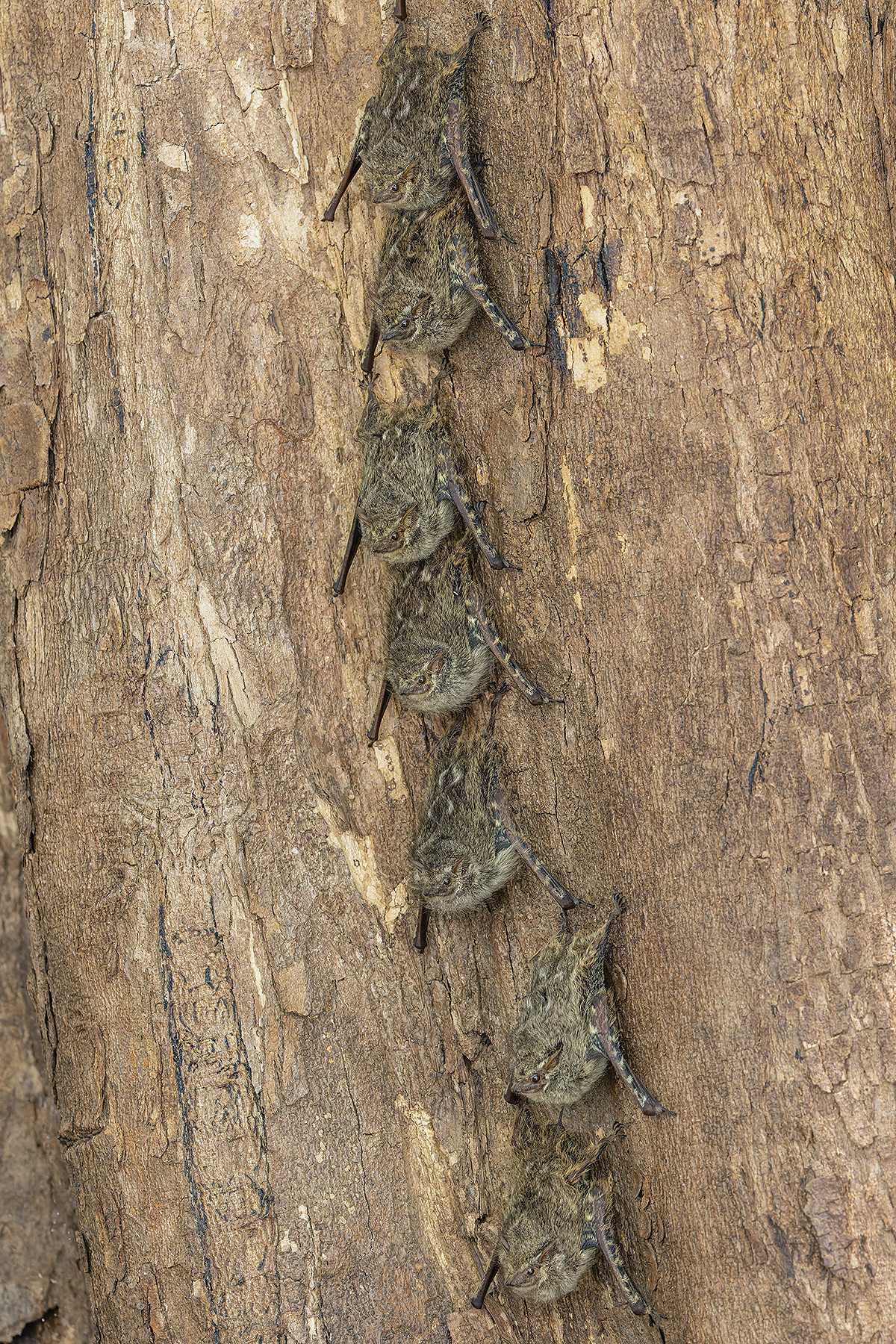
A Brazilian Long-nosed Bat colony (image by Pete Morris)

Preening Agami Heron (image by Pete Morris)

Although common, the Southern Lapwing is still a very handsome bird (image by Pete Morris)

A Yellow Anaconda enters the river with its tongue forked to test the waters (image by Pete Morris)

A Chestnut-bellied Guan wanders the forest trails (image by Pete Morris)

Look at those teeth! (image by Pete Morris)

Stunning views of a Monk Parakeet flock in flight (image by Pete Morris)

Eye level with a Jabiru feeding its chicks (image by Pete Morris)

Large Red-legged Seriemas are not only great photo subjects, they also have really charismatic calls (image by Pete Morris)

Bare-faced Curassow female (image by Pete Morris)

A gregarious group of Giant Otters (image by Pete Morris)

Neotropical River Otter (image by Pete Morris)

A Rufous Hornero takes a break from foraging in the flowers (image by Pete Morris)

A Giant Otter chomping on his freshly caught fish (image by Pete Morris)

Two Hyacinth Macaws enjoy a tender moment (image by Pete Morris)

A mother Jaguar hunting with her cub in the Pantanal (image by Pete Morris)

Hyacinth Macaws are always a highlight of our Pantanal tours (image by Pete Morris)

Beautiful Chestnut-eared Aracari (image by Pete Morris)

Bare-faced Curassow male (image by Pete Morris)

Portrait of a Black-striped Tufted Capuchin (image by Pete Morris)

Aquatic Capybara (image by Pete Morris)

The Pantanal isn't all about Jaguars. Ocelots also steal the feline show (image by Pete Morris)

Jaguars live in the most beautiful riverine forests of Brazil's Pantanal (image by Pete Morris)

Lesser Yellow-headed Vulture (image by Pete Morris)

A Large-billed Tern lands on a Pantanal river beach (image by Pete Morris)

Agami Herons are one of the Pantanals much sought after birds for photographers (image by Pete Morris)

A Pale-crested Woodpecker takes a break from scaling a palm in the Pantanal (image by Pete Morris)

Pauraque (image by Pete Morris)

A foraging Red-crested Cardinal (image by Pete Morris)

Portrait of a Green Ibis (image by Pete Morris)

Capped Heron in flight (image by Pete Morris)

Great Potoo in camouflage (image by Pete Morris)

Portrait of an American Barn Owl (image by Pete Morris)

A Jaguar enters the river (image by Pete Morris)

Statuesque Jaguar looks down the river from a tree branch (image by Pete Morris)

A Grey Cowled Wood Rail reflection (image by Pete Morris)

Warm sand is perfect for a Black Skimmer siesta (image by Pete Morris)

The vividly beautiful hues of Hyacinth Macaws (image by Pete Morris)

Peach-fronted Parakeet in flight (image by Pete Morris)

A shy Boat-billed Heron (image by Pete Morris)

Sublime Pantanal sunrise (image by Pete Morris)

When the heat of the day becomes too much it's time for a siesta (image by Pete Morris)

Prowling Jaguar (image by Pete Morris)

A Toco Toucan tossing his fruit lunch into the air (image by Pete Morris)

Southern Screamer screaming during flight (image by Pete Morris)

Jaguar's tongue (image by Pete Morris)

A Jaguar expertly climbs down a river bank (image by Pete Morris)
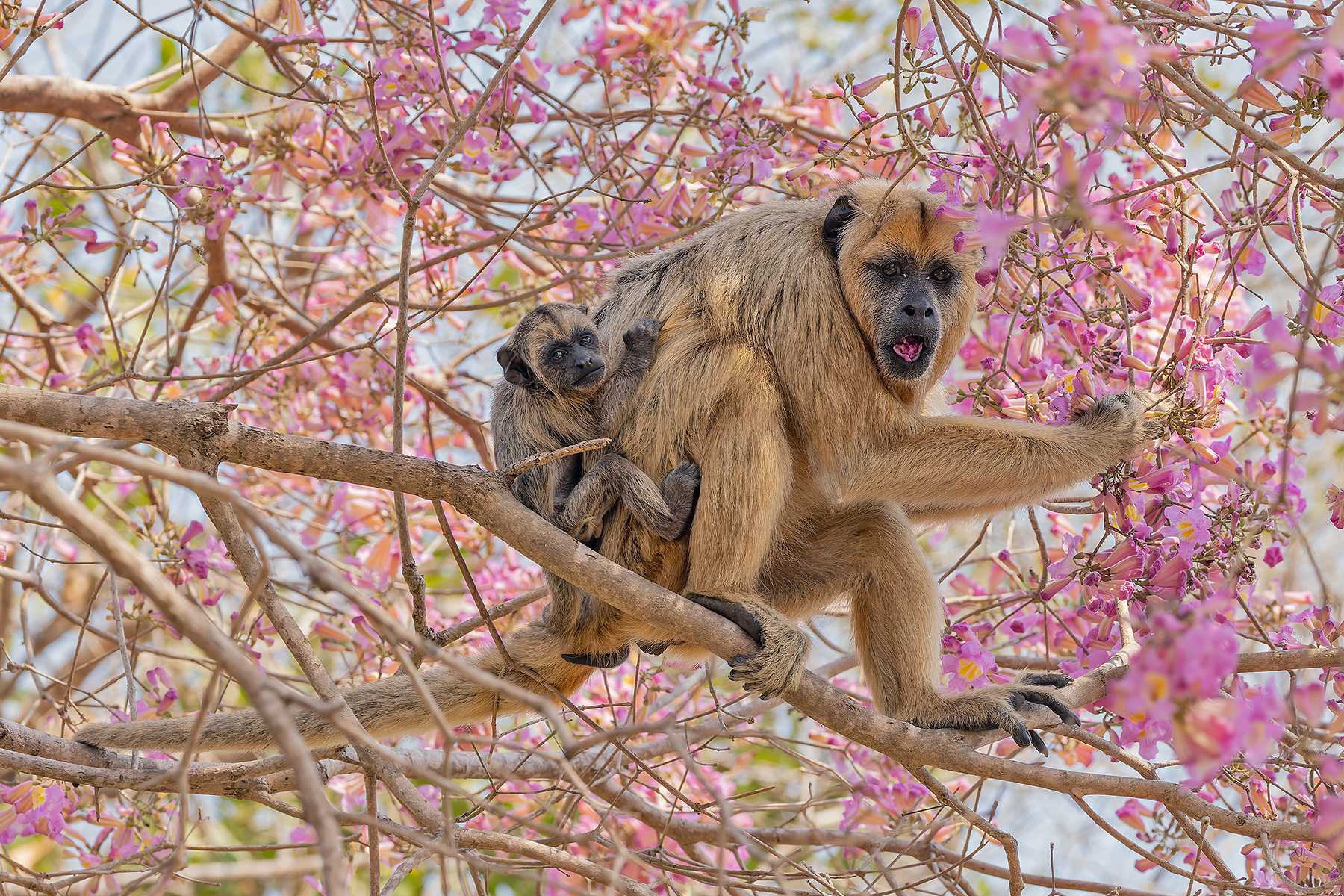
A female Black and Gold Howler Monkey with its youngster in a flowering Ipe tree (image by Pete Morris)
Wow! Once again Brazil totally delivered, and our short and action-packed itinerary along the famous Transpantaneira and into the heart of the northern Pantanal was packed with wildlife and amazing photographic subjects from start to finish! Called ‘Terra de Ninguem’ (No Man’s Land) by the Brazilians, the Pantanal is a vast alluvial plain, half the size of France, situated at only 100 metres above sea-level and inhabited by just a few thousand people. Receiving the run-off from the Planalto Highlands of southwestern Brazil, this immense and seasonally flooded area is essentially a huge inland river delta.
The Pantanal is simply one of the natural wonders of the world and is, without question, the best place to photograph the magnificent Jaguar, and this was certainly the main purpose of our visit for most of us. However, we were also enticed by the very impressive supporting cast of other photogenic wildlife with mouth-watering hoped for encounters including the delightful Ocelot, the impressive Giant Otter, Brazilian Tapir and the extraordinary Giant Anteater. In addition, around 1000 bird species have been recorded in the Pantanal! Of course a single visit will only record a fraction of these, but it was plenty to keep me on my toes and to share with the willing group, who seemed keen to see as much of the amazing diversity as we could manage!! Amongst these were some really iconic species such as Hyacinth Macaw, the world’s biggest parrot, Toco Toucan, the world’s biggest toucan, the impressive Jabiru, the world’s biggest stork, amazing Red-legged Seriemas and a plethora of other goodies!
We began our trip at Cuiabá the capital of the state of Mato Grosso in southwestern Brazil, and, once assembled, and accompanied by our excellent guide Marlon, we made our way towards Poconé, the gateway to the northern Pantanal. We made a quick stop for refreshments and then began our journey along the Transpantaneira, a dirt road that runs from Poconé southwards towards the border area between Brazil and Bolivia. The road has more than a hundred bridges and runs through a variety of habitats including pastures, palm groves, gallery woodland, scrubby growth, meandering rivers, ponds and extensive flooded marshes.
Leaving Poconé, almost immediately the wildlife was in evidence! Yacare Caimans, Jabirus and a horde of other waterbirds inhabited the borrow pits along the side of the road, and immediately the shutters went into overdrive. Indeed it was difficult to encourage the group back on to the bus for long enough to get anywhere, but we did eventually tear ourselves away from the endless waterbird spectacles, and make our way into the very pleasant Pouso Alegre lodge, our base for the first two nights of the tour.
Pouso Alegre is a former cattle ranch or ‘fazenda’, where a series of lakes and ponds, which remain into the dry season, are set within a picturesque open cerrado landscape with small patches of gallery forest.
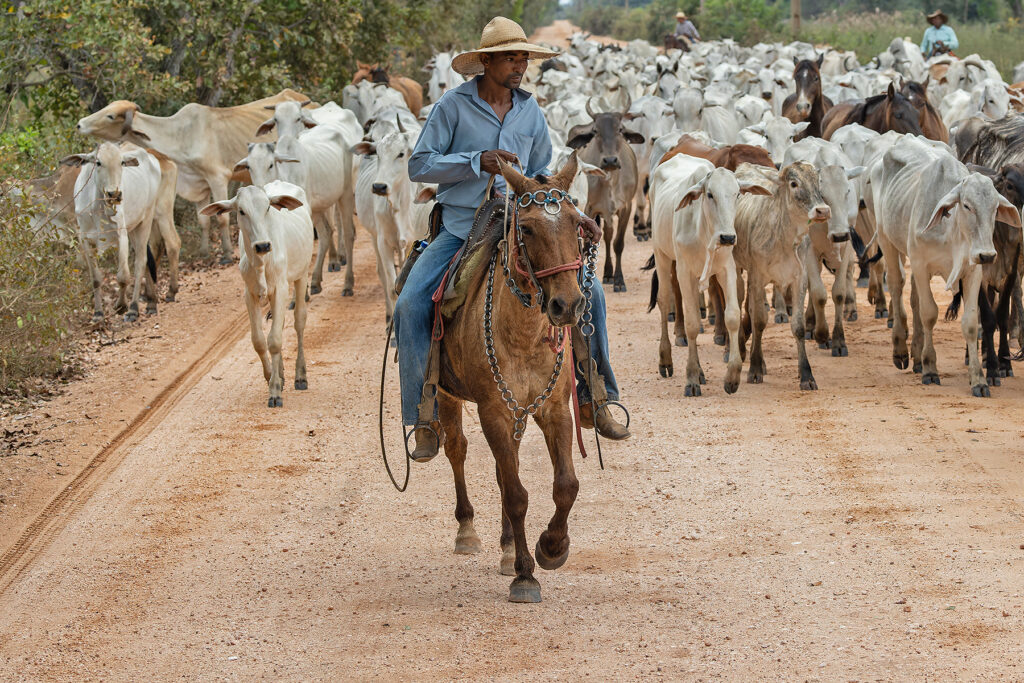
The Pantanal’s iconic cattle ranchers herding their cows along the road (image by Pete Morris)
Sadly, a vast fire swept through the northern Pantanal a few years ago, and some of the wildlife (especially larger mammals such as anteaters and tapirs) is still recovering from that. That said, we still had a great stay, and although we did not find any anteaters, despite extensive searching, we had a great number of other fantastic sightings. A couple of wonderful Brazilian Tapir sightings were very much appreciated, and we had fantastic photographic opportunities at the feeders, where amazing Toco Toucans (with their banana-shaped bills and glorious blue eyerings) and Chestnut-eared Aracaris delicately tossed morsels up and gulped them down, while huge Bare-faced Curassows and South American Coatis wondered around below them. Plenty of other wildlife was in evidence around the lodge, and we had great encounters with Chestnut-bellied Guans, a roosting Great Potoo, our first incredible Hyacinth Macaws, several species of woodpecker including the attractive Pale-crested Woodpecker, and the interesting Great Rufous Woodcreeper. Out in the marshy areas we found striking Rufescent Tiger Herons, smart Plumbeous and Green Ibises, and a variety of other interesting avian subjects, and we also found our first Capybaras as well as some Crab-eating Foxes and Marsh and Red Brocket Deer.
After a great stay, we said goodbye to our hosts and made our way a short distance further south on the Transpantaneira to the pleasant Santa Tereza lodge. Unfortunately we now seemed to be in the grip of a ‘friagem’ as a cool breeze and rain had set in, and it really had become positively cold! Indeed it was a far cry from the searing heat and failing air-conditioning as we drove away from Cuiabá just a couple of days earlier! In fact the weather was so bad that we cancelled the afternoon’s programme and put our feet up!
In the evening we were supposed to look for the charming Ocelot but were told by the lodge owners that there was really no point due to the weather! Now I am not a defeatist, or easily put off, so I assured them that we were happy to give it a go anyway. We assembled, and as the light faded, a hungry Ocelot appeared immediately and delighted us for the next 30 minutes or so! What an incredible experience!! Despite the cold and damp weather we returned to the lodge with beaming smiles on our faces. A cold beer and another fine buffet dinner were much appreciated! At this point I should mention the food… Well, it’s great! Every meal was a buffet with masses of choice for everyone, with lots of fresh fruit and salads as well as plenty of heavy main courses. Once washed down with a Caipirinha, I think it’s fair to say that this was not a trip for anyone on a calorie controlled diet, especially if you have as little self-restraint as me!!
The following day we had two main activities. One was to spend time around the lodge where numerous attractive species came to feed, including more impressive curassows, and from where one could access the tower. The tower gave us an amazing view into the life of a family of Jabirus, as one literally peered straight into the nest and could watch everything going on as the parents brought food, water and fresh foliage. A magic experience, made all the better by the Monk Parakeets nesting in the stork’s nest in tower block fashion!
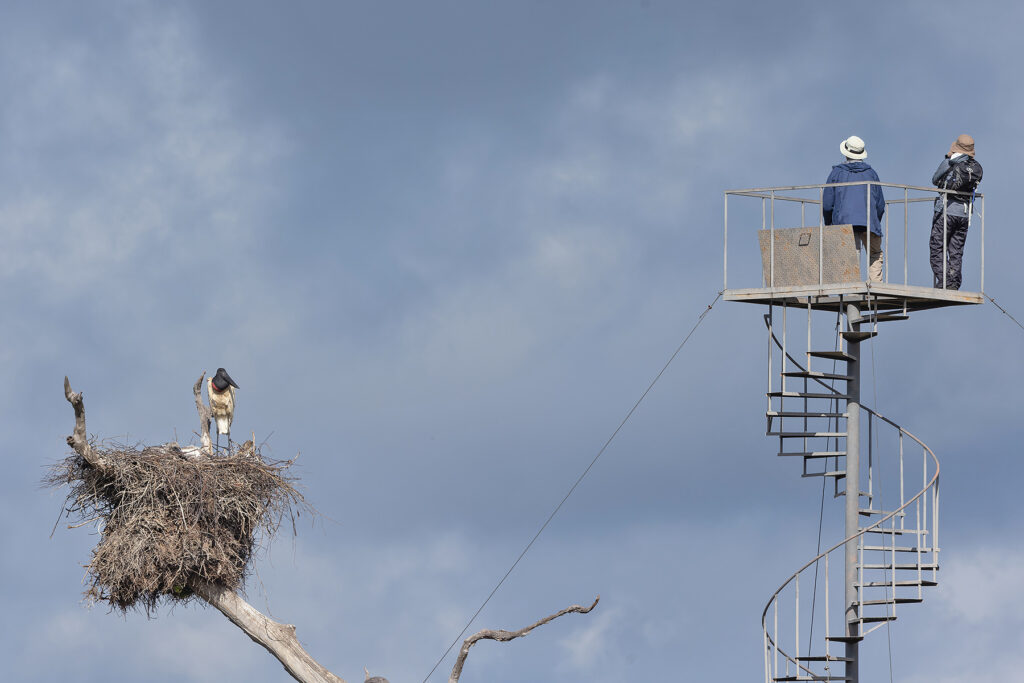
The Stork Tower in the Pantanal (image by Pete Morris)
We also had a few sessions on the river here which were also great fun. Photographing Black-collared Hawks diving down for piranhas became a new favourite past time, but we also saw gorgeous Sunbitterns, lovely Sungrebes, and a plethora of different herons, egrets, ibises, kingfishers and other waterbirds. Perhaps most notable were the fabulous Agami Herons, surely the best-looking heron in the world, and the smart Green-and-rufous Kingfisher, the scarcest and most difficult Neotropical kingfisher to photograph.
That evening we once again visited the Ocelot, though this time we were accompanied by a large number of other guests. Sadly, we were unaware of the rules, and found ourselves in front row seats ready for the show! A violent and noisy scrap between the Ocelot and a Crab-eating Fox kicked off proceedings, but then things calmed down and the Ocelot once again thrilled us as it chomped noisily through its chicken treats! What a great animal!! We also went on to see some American Barn Owls around the lodge later that evening!
After a final river trip, we made our way to the Hotel Pantanal Mato Grosso for yet another lavish lunch, and a look around their grounds. Not a lot was on show, though we did have some nice encounters with Campo Flickers and some parakeets. We then again made our way further south along the Transpantaneira. The weather was still cool, but far better, and the abundance of wildlife as we drove was amazing. We began to see an enormous number of caimans, and paused for various smart waterbirds such as impressive Southern Screamers and Maguari Storks. We also encountered a number of Nacunda Nighthawks around a pool which made an interesting subject. Again we had to pull ourselves away in order to make our way down to Porto Jofre and the hotel Pantanal Norte, our base for nearly the next week. This fabulous hotel really was much appreciated by us all. It gave us the opportunity to stroll around the grounds in our down time, and even after dinner, gave us access to an excellent talk all about the Jaguar Project, and gave us spacious comfortable rooms and enormous and lavish meals! I think it’s fair to say that as we passed the ‘Flotels’ at dawn and dusk each day, most of us thought “I wonder what it’s like on one of those boats?” but I’m pretty certain that none of us were too bothered about finding out! Our base was just perfect!
We spent the next six days making excursions by boat on the slow-flowing Cuiabá River and its tributaries. Each day followed a pretty similar routine: this involved an early breakfast (lavish buffet and take-outs if required!!); getting out on the river before sunrise; watching the spectacular sunrise; exploring the river until late morning; a good lunch; a break (siesta if desired!!); and then an afternoon trip back out on the river enjoying sunset as we returned! This was of course followed by a lavish dinner and the optional Caipirinha. What’s not to like??!!
With our excellent boatman and guide, and thanks to the way the boatmen share information by radio, we always felt that we were in the game, and indeed we had Jaguar encounters on every single one of our excursions, often multiple encounters! And boy the boat was one powerful beast, so getting to sightings could be pretty rapid at times, as it was capable of clocking up over 70kph, making the boat rides alone a bit of a thrill!
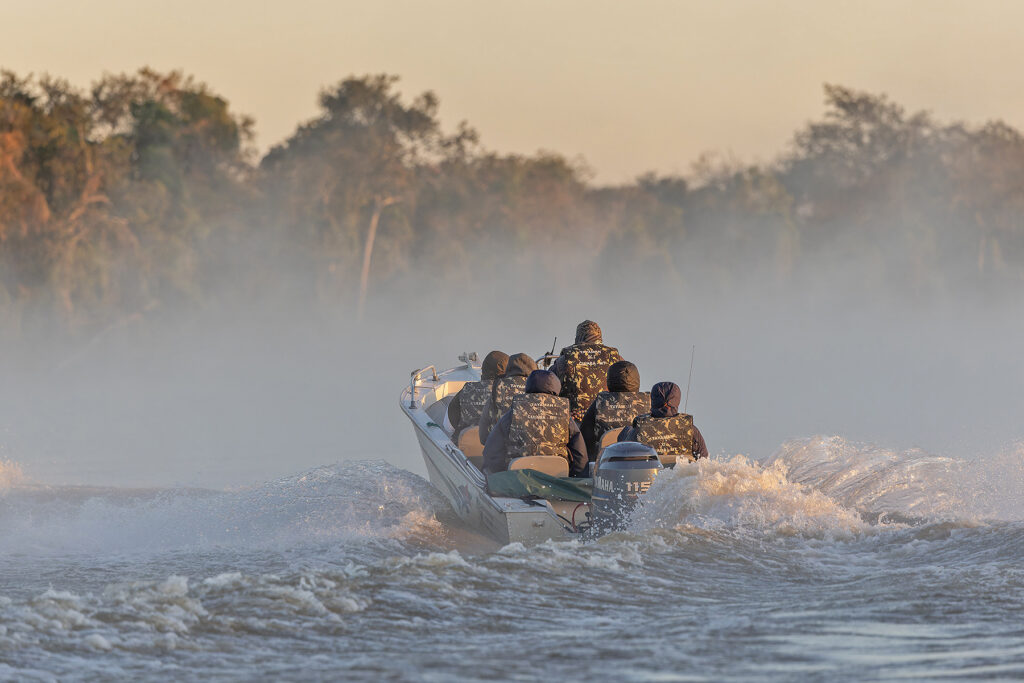
And they’re off! The first sighting of a Jaguar gets everyone racing (image by Pete Morris)
Although the magnificent Jaguar is still quite widespread in Central and South America, occurring from northern Mexico south to central Argentina (including most of Brazil), it is only rarely seen elsewhere in its range. Jaguars are usually associated with large tracts of dense rainforest, but it is now known that they feel equally at home in more open habitats, with a very marked preference for the immediate vicinity of watercourses, making them most easily detectable from boats. Hunting of Jaguars ceased a long time ago in the Pantanal of Brazil, and as a direct result these magnificent creatures have gradually become less afraid of people, so much so that many of them now seem to completely ignore their boatloads of admirers. The Pantanal holds the highest density of this enigmatic creature and the largest individuals live here in the southern Mato Grosso of Brazil, where average adults usually weigh twice as much as their relatives in Central America at up to 140 kilograms (300 pounds)!
Our encounters were many and varied but always exciting. Our very first sighting was particularly memorable. After several blank hours on our first morning, we encountered a female hunting along the riverbank. Suddenly there was a big splash, and she emerged dragging a big caiman out of the river, pausing to look at us as she went! Wow what a way to first see this beast! Many Pantanal Jaguars prey on caimans, their ultra powerful jaws enabling them to bite through the crocodiles’ skulls, killing them almost instantly, and enabling them to capture prey almost as heavy as themselves!
Every encounter was different and enjoyable, and it’s fair to say, we were happy and sated by the end of our trips. We had a Jaguar walking across a beach at sunrise; females lounging with cubs; cubs playing together; Jaguars lounging on logs; a Jaguar climbing a tree and then sleeping in it; a Jaguar flying through the air and splashing into the water attempting to catch a caiman; Jaguars sneaking up on Jabirus and screamers; Jaguars swimming across rivers; Jaguars just a few metres away; in fact we saw Jaguars just being Jaguars and enjoyed every minute of every scenario. Indeed, even on day six on the river the mere mention of the word Jaguar got the pulses racing! I think one thing we found incredible was how quickly a Jaguar could just vanish. One minute they’d be in full view, the next they’d sink down into a bit of marsh and appear 100m away, or simply disappear. Quite amazing!
But it wasn’t just the Jaguars. Yes, they stole the show, but there was plenty more to keep us focused when they were not around. We were simply amazed by the numbers of Yacare Caimans we saw. It is estimated that as many as 10 million Yacare Caimans inhabit the waters of the Pantanal – crikey there must be a lot of fish in there! Fish that sustain the Giant Otters, another species that we spent many magical minutes with! One moment a family group would all be swimming along together, cheeping excitedly, the next they’d all dive down and appear with fish which they would proceed to noisily chomp down in front of us! Sometimes they’d clumsily make their way on to land, and on one particularly memorable occasion we watched a family climb a muddy bank and then slide back down, covered in muck! We also had fun with the habituated Neotropical River Otter around the camp. This adorable individual was rescued from a fire and enjoyed human contact, even taking a dip in the swimming pool! I was worried she was going to be squirreled away into a suitcase and taken home!!
On occasions we could admire howler and capuchin monkeys along the trees lining the river banks, whilst on the banks, awkward Capybaras loafed, weary of their security as they make tasty meals for Jaguars! Our skilled boat driver also pulled us up alongside other wildlife such as a huge Yellow Anaconda and some impressive iguanas. There were also, of course, a plethora of birds to photograph as well. We spent time watching Black Skimmers (even skimming!), and saw attractive Yellow-billed and Large-billed Terns and Pied Plovers on the sandbanks, whilst at the riversides, White-throated Piping Guans (note the form we saw has just been ‘split’ from Blue-throated) and Bare-faced Curassows came to drink. Smart Boat-billed and Capped Herons were admired, numerous kingfishers and woodpeckers posed in riverside trees, and we noted plenty of raptors, including an impressive pair of Laughing Falcons. Each evening, as we made our way back the river would suddenly come alive with nighthawks and fishing bats, a nice way to round off the trip. Of course there were many, many more species encountered and photographed, and each of us will have our own little favourites. There was just so much to enjoy!
We also spent some time around the lodge where, as well as the habituated otter, we also admired the Hyacinth Macaws, and found other interesting subjects such as a Pantanal Snipe, American Barn Owls, Nacunda Nighthawks and a variety of waterbirds. It had been a brilliant base and a brilliant stay! In fact it had been so good that we decided to leave a little early. Not because we’d had enough, but because we’d seen so much and we had unfinished business to do. We made our way back north along the Transpantaneira to the lovely Pousada Piuval, as there was a Giant Anteater undercurrent affecting the group! We tried on arrival, and although we had no luck, we did have another fabulous encounter with two Brazilian Tapirs, were delighted to watch and photograph good numbers of Greater Rheas, and enjoyed comical Red-legged Seriemas screaming at us from just metres away!
Early the next morning we were in luck, and actually saw two amazing Giant Anteaters. Both were a little timid, but everyone got to see and get some record shots of this incredible species. It really is a creature that has to be seen to be believed! We then enjoyed the fabulous grounds of the lodge for the rest of the morning, enjoying fabulous Black-and-gold Howlers munching on flowers, diminutive Cinnamon-throated Hermits at their lek, and an excellent variety of other wildlife and birds. One rather macabre sighting was that of a large Yacare Caiman killing a smaller one and sitting there with its head in its jaws! A grim sight but then that’s how a big caiman becomes big!!
After a final lavish lunch, we retraced our steps back north along the Transpantaneira, just as the next ‘friagem’ was hitting. It became cloudy and cold, and once again precipitation was in the air. It seemed like the right time to be leaving, and as we made our way back to Cuiabá Airport we could reflect back on our amazing adventure. It really had flown by, but our minds and memory cards were now full of incredible memories and images! The Pantanal really is a wildlife photographer’s dream; without doubt one of the best destinations there is!































































































































































